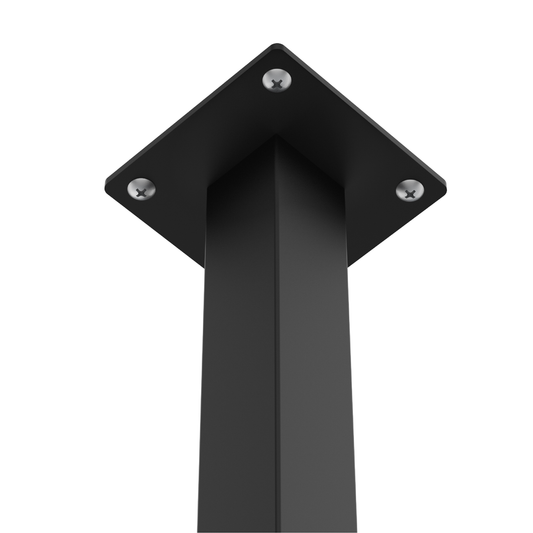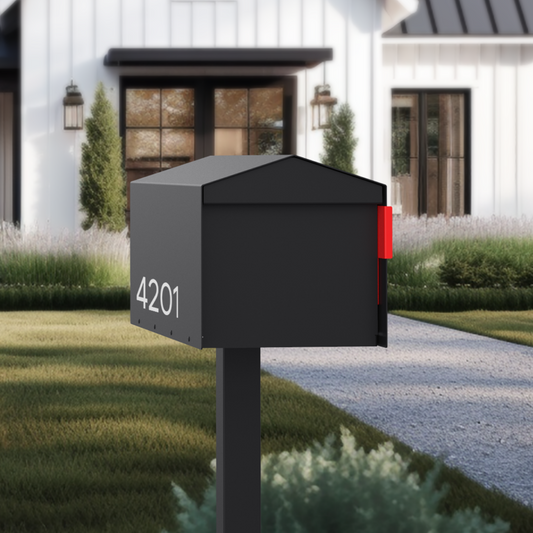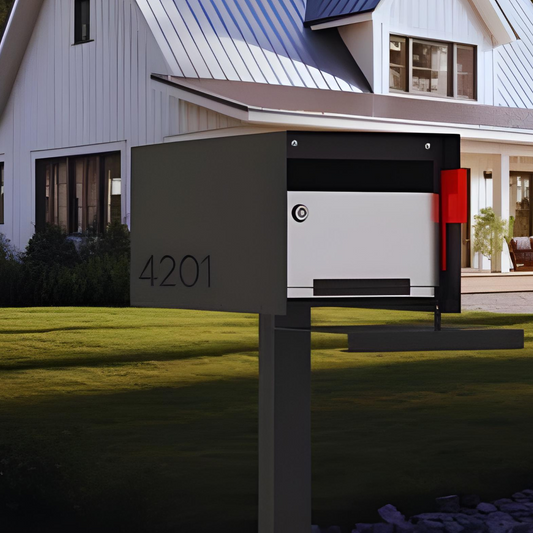USPS regulations exist for a reason. They help standardize mail delivery, protect mail carriers, and reduce safety risks in neighborhoods across the country.
Consistent mailbox placement is a requirement for homes as carriers operate from right-hand drive vehicles.
Skipping the rules can lead to more than missed mail. Poorly installed or placed boxes have caused accidents, legal issues, and damaged property.
So what does it take to get a post-mounted mailbox right the first time?
Following official USPS guidelines for height, setback, materials and structure, ensures your mailbox is compliant and ready for daily delivery. It also supports mailbox security, helping you avoid delivery interruptions and potential fines.
In this guide, we'll walk you through the exact USPS requirements for installing a safe, compliant post-mounted mailbox.
USPS Mailbox Approval Process
Before installing a new mailbox, it's important to understand how USPS approval works. Whether you’re choosing a standard model or designing something custom, following the right steps ensures your mailbox is safe, accessible, and fully compliant with mailbox installation rules.
The PMG Seal of Approval
All commercially manufactured mailboxes must meet USPS-STD-7B or 7C standards. These cover strength, durability, security, usability, and weather resistance to ensure every mailbox holds up under regular use.
Once a mailbox passes testing, it’s officially approved by the Postmaster General (PMG) and labeled as compliant. Choosing a PMG-approved mailbox removes the guesswork and helps you avoid installation delays or delivery issues.
Custom Mailbox Designs
If you’re installing a handmade or non-standard mailbox, approval is a little different. You must submit the design to your local Postmaster for review. Even custom boxes must meet basic USPS guidelines for size, durability, and mail carrier access.
Builders or homeowners often need to provide drawings or samples to show that the box will work within the established system, including meeting the USPS mailbox height requirement.
Construction Standards for Post-Mounted Mailboxes
When choosing a post-mounted mailbox, you need to meet the technical standards that ensure safe use and USPS compliance.
These rules apply to both standard and locking mailboxes.
- Only plastic or metal materials are allowed for floors, doors, and signal flags—no wood.
- Mailboxes must have raised floors (at least 0.12 inches of ribbing) to prevent condensation and protect mail from moisture.
- The door must open between 100° and 180° and stay open without assistance.
- The door must require no more than 5 pounds of force to open or close.
- Spring-loaded or friction-closure doors are not allowed under USPS regulations.
- The interior must be smooth with no sharp edges or exposed hardware that could damage mail or injure carriers.
You can find the full set of USPS construction standards here to make sure your mailbox choice stays compliant and safe.
Size & Capacity Guidelines
Choosing the right size mailbox is critical for safe delivery and long-term use. USPS has clear standards for what sizes qualify as compliant, whether you’re installing a basic post-mounted model or a larger, locking option.

Picking a properly sized box ensures smoother service and makes your PMG-approved mailbox easier for carriers to use.
- Standard Size Requirements: A standard mailbox must fit within USPS gauge dimensions of 7 inches high × 13 inches wide × 16 inches deep. This sizing allows enough space for regular letters, magazines, and small parcels.
- Large Capacity Options: For homes that receive more frequent or bulkier deliveries, consider a T3-sized model. These can measure up to 22.5 inches long × 8 inches wide × 11.5 inches high, offering more room without violating standards.
- Locking Model Requirements: Locking mailboxes must accept unfolded USPS Priority Mail envelopes through the incoming slot without needing to bend or force them.
Size is just one part of compliance. Placement also matters. Always follow the correct mailbox setback distance and mounting guidelines to stay fully aligned with USPS rules.
Placement Rules: Height, Distance, and Road Position
Getting mailbox placement right is just as important as choosing the right box. USPS has clear curbside mailbox requirements that help carriers deliver safely and efficiently. Following the correct setup ensures your mailbox is accessible and compliant.
Mailbox Height
The USPS mailbox height requirement is 41 to 45 inches from the road surface to the bottom of the mailbox or point of mail entry. This range ensures carriers can deliver without leaving their vehicle. Always measure from the finished surface of the road, not from the soil or grass height.
Curb Distance
The mailbox should be set back 6 to 8 inches from the curb’s edge. This distance gives carriers enough space to pull up and deliver without needing to exit the vehicle. If there’s no raised curb, measure from the edge of the road surface. Correct curb distance also helps prevent damage from passing traffic.
Side of Road
Mailboxes must be installed on the right-hand side of the road in the carrier’s direction of travel. This standard keeps mail routes efficient and safe for carriers. Homeowners in rural areas or less developed neighborhoods should check specific local guidance.
More details about placement are provided in the USPS mailbox installation bulletin for easy reference.
Mailbox Post Installation & Safety Requirements
Installing your mailbox correctly requires an understanding of postal rules. You also need to ensure the safety of drivers, pedestrians and your property.
USPS enforces clear guidelines to make sure mailbox posts stay safe and compliant at all times.
Check out these tips if installing a DIY mailbox post.
Approved Materials
Mailbox posts must be built from materials that are safe and forgiving in case of a vehicle impact. Approved materials include:
- 4x4-inch wooden posts
- 2-inch diameter steel or aluminum pipes
Materials like concrete, brick, stone, or solid metal are not allowed. These materials create rigid obstacles that can cause serious damage or injuries during accidents.
Burial Depth and Breakaway Requirement
Posts must be buried no deeper than 24 inches into the ground. Deep posts become too rigid and fail to meet breakaway standards. The post must be designed to bend, break, or collapse safely if struck by a car, reducing the risk of injury and property damage.
Legal Liability
Homeowners are legally responsible for any injuries or property damage caused by unsafe mailbox installations. USPS regulations align with the Federal Highway Administration (FHWA) safety standards to protect everyone on the road.
Keep It Clear: Carrier Access Rules
Even if your mailbox is installed correctly, blocked access can lead to missed deliveries. USPS has specific rules to ensure carriers can approach, deliver, and move on without unnecessary delays or risks.
Obstructions That Block Delivery
Your curbside mailbox must remain fully accessible at all times. Common obstructions that prevent safe delivery include:
- Parked vehicles in front of or near the mailbox
- Trash bins placed too close on collection days
- Accumulated snow or ice around the base
- Landscaping features like overgrown bushes, fencing, or dense flower beds
Keeping the area clear ensures carriers don’t need to exit their vehicles or skip your address.
Carrier Safety Guideline
When mail carriers cannot reach your mailbox without leaving their vehicle, USPS may issue a PS Form 4056 as a warning or suspend delivery until the issue is resolved. To stay compliant and avoid missed mail, make sure your setup aligns with these USPS carrier access rules.
Mailbox Identification Requirements
Proper identification is a key part of USPS compliance. It helps carriers deliver accurately and prevents confusion, especially in neighborhoods with similar addresses.

Following these basic rules ensures your mailbox is easy to find and service.
- Your house number or box number must be at least 1 inch tall so it’s clearly readable from the street.
- The numbers should be in a contrasting color to the background of the mailbox to maximize visibility.
- If your post-mounted mailbox isn’t directly in front of your home, you also need to include the full street name along with the house number.
- For extra visibility at night or in low-light conditions, using reflective number stickers is strongly recommended.
Clear and visible mailbox identification not only helps with deliveries but also supports emergency services and visitor navigation.
Locking Mailboxes: What’s Allowed
Many homeowners are choosing locking mailboxes for added security, but they still need to meet USPS guidelines. The postal service allows locking models as long as they don’t interfere with delivery access or safety.
To comply, the incoming mail slot must be at least 1.75 inches high and 10 inches wide. This ensures that standard letters, magazines, and USPS Priority Mail envelopes can be delivered without bending or damage.
Carriers must be able to deposit mail without needing a key or access code. USPS also prohibits after-market conversions or DIY lock kits, which often fail to meet official standards.
All locking mailboxes must meet the USPS-STD-7C security standard for strength, accessibility, and usability.
If you're looking for a compliant option that meets these requirements and looks great, Olio Home’s Thompson Flat-Top Mailbox is a reliable choice designed with both security and style in mind.
Newspaper Holders & Add-Ons
If you want to add a newspaper holder to your post-mounted mailbox, there are specific USPS rules you need to follow.
The newspaper holder must not touch the mailbox itself or be attached directly to the mailbox structure. It should be a separate piece, mounted below or near the mailbox without interfering with its function.
The holder must not block the carrier’s access to the door, obstruct the mailbox flag, or extend beyond the front face of the mailbox. Only the newspaper’s name or logo can appear on the holder as promotional materials or unrelated advertisements are not allowed.
Keeping these details in mind ensures your mailbox setup stays clean, compliant, and fully accessible for daily deliveries.
No Advertising Allowed
USPS has strict rules when it comes to what can and cannot appear on your mailbox. These regulations help protect the official use of mailboxes and prevent confusion for carriers and residents.
- Stickers are not allowed on any part of the mailbox
- Signs, including personal or business advertisements, are prohibited
- Business branding, logos, or marketing material cannot be displayed
Mailboxes are intended for official USPS mail only. You cannot use your mailbox to distribute flyers, ads, or promotional materials of any kind. Following these rules keeps your setup compliant and avoids potential delivery interruptions or fines.
Mailbox Maintenance Is Mandatory
A properly maintained mailbox is a basic USPS requirement. Regular upkeep ensures safe, reliable mail delivery and helps your mailbox last longer, especially with daily use and exposure to the elements.
As the owner of a post-mounted mailbox, you’re responsible for keeping it in working condition. Here’s what to check regularly:
- Rust, rot, or corrosion on the mailbox or post
- Loose screws, bolts, or mounting hardware
- A leaning, cracked, or damaged post
- Worn, faded, or missing address numbers
Ownership
The USPS does not maintain residential mailboxes. Maintenance, repairs, and replacements fall on the homeowner.
USPS only handles upkeep for centralized or community mailbox units (CBUs) that it owns or manages. Keeping your individual mailbox in good shape is your responsibility.
When to Contact Your Local Postmaster
Some mailbox situations require approval or guidance from your local Postmaster. Reaching out early can prevent delivery disruptions and ensure your setup meets USPS requirements.
You should contact your Postmaster if:
- You’re switching from a wall-mounted to a post-mounted mailbox
- Your property has no curb or clear street edge for standard placement
- You’re installing a custom-built mailbox that doesn’t follow typical specs
- You’re part of a shared or clustered mailbox setup that needs coordination
These situations may involve additional rules, and your local USPS office can help you get it right.
USPS Compliance Checklist (Recap Section)
|
Feature |
Requirement |
|
Height |
41–45 inches from the road surface |
|
Setback |
6–8 inches from the curb |
|
Roadside Placement |
Right-hand side (carrier’s route) |
|
Post Depth |
Max 24 inches |
|
Approved Posts |
4x4 wood or 2" aluminum/steel only |
|
Locking Slot Size |
Minimum 1.75" H × 10" W |
|
Address Numbering |
1” high, contrasting color, street-visible |
FAQ Section
Can I use a mailbox that doesn’t have the PMG (Postmaster General) seal?
Only if your local Postmaster has reviewed and approved your custom mailbox design.
What is the required height for a USPS-approved post mounted mailbox?
The bottom of the mailbox must be between 41 and 45 inches from the road surface.
How far back should the mailbox be from the curb or road?
The front of the mailbox should be 6 to 8 inches back from the curb or edge of pavement.
Can I install a mailbox on a concrete or brick post?
No. USPS prohibits rigid posts like concrete, brick, or stone due to safety concerns. Posts must be breakaway-style.
Is a locking mailbox allowed under USPS rules?
Yes, as long as the mail slot is at least 1.75" high × 10" wide and the carrier doesn’t need a key.
Do I need permission to switch from wall-mounted to post-mounted?
Yes. You should contact your local Postmaster to verify placement and USPS approval.
Can I paint or decorate my mailbox?
Yes, but decorations cannot obstruct the flag, address numbers, or the mailbox door. No ads or logos allowed.
What are the consequences if my mailbox is not compliant?
USPS may issue PS Form 4056, suspend delivery, and/or require corrective action.
Can my mailbox share a post with a newspaper box?
Only if the newspaper box does not interfere with USPS access or flag visibility. It must not be attached to the mailbox.
What if I don’t have a curb at my property?
Contact your local Post Office. They’ll provide specific placement instructions based on your road conditions.
Who is responsible for mailbox repairs and maintenance?
The homeowner is responsible. USPS does not maintain residential mailboxes.
Can I use aftermarket locks on my existing mailbox?
No. USPS discourages DIY modifications that block access or alter mailbox standards.
Is there a fine or penalty for violating mailbox regulations?
While there’s no fixed fine, delivery may be suspended, and you may be liable in case of property damage or injury caused by unsafe installations.
What type of post should I use?
USPS recommends using a 4x4 wooden post or a 2-inch diameter standard steel or aluminum pipe for mailbox installations. These materials meet safety standards because they can bend or break away if struck by a vehicle.
Learn more about post mounted mailboxes.




